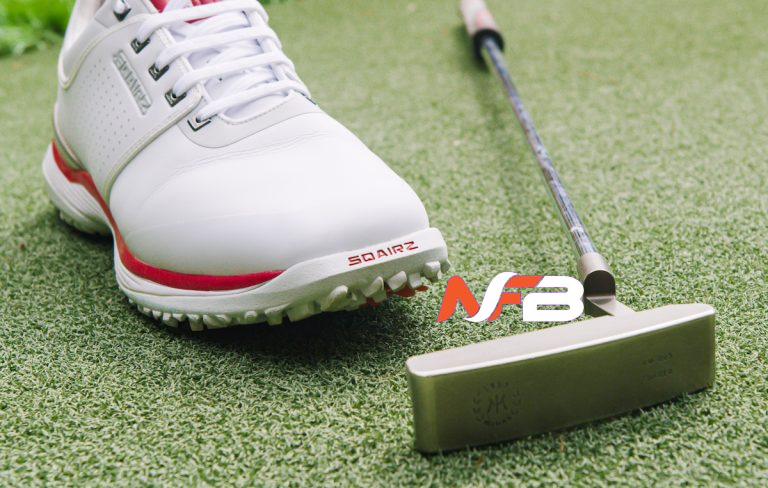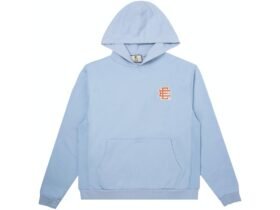As you approach the tee, the way your body interacts with the ground significantly influences the outcome of your next move. A strong, precise swing originates from a solid foundation underfoot. In golf, where precision is paramount and even the slightest adjustments can influence the outcome, any misstep, imbalance, or limitation in foot movement can significantly impact performance. That’s why selecting the appropriate footwear transcends mere comfort; it serves as a fundamental biomechanical support.
Specifically, wide fit golf shoes are essential for improving stability, balance, ground force transfer, and endurance. In this blog, I will explore how Fitville is integrating scientific principles into its designs, enabling you to enhance your swing, extend your walk, and maintain comfort throughout 18 holes.
Why Footwear Matters in Golf: Biomechanics & Ground Force
In contemporary golf studies, a recurring theme is the ground reaction force (GRF). As you propel yourself from the ground during the swing, the ground responds with an equal and opposite force. The influence of that force leads to torque, weight transfer, and ultimately enhances clubhead speed. A stronger connection to the ground—through friction, stability, and foundation—enhances your ability to transfer forces seamlessly from your legs, hips, and torso into the club.
Nonetheless, a significant portion of that energy transfer is diminished if your feet are slipping, shifting, or sliding within shoes that fail to provide a complete connection. Golfers wearing ill-fitting shoes might inadvertently reduce their power just to maintain grip. When footwear limits toe splay or constricts forefoot movement, it diminishes your foot’s ability to grip or make subtle adjustments, ultimately compromising your stability and responsiveness.
A thoughtfully designed golf shoe needs to harmonize three essential elements: a reliable heel lock to prevent foot movement, a stable midfoot frame to minimize unwanted twisting, and a forefoot that allows for natural biomechanics without restriction. The forefoot is especially where wide fit golf shoes truly stand out. They enable your toes to spread naturally, allow your forefoot to engage effectively, and alleviate pressure points that might otherwise disrupt or hinder force transfer.
In a thoughtful examination of footwear factors in golf swing biomechanics, LER Magazine emphasizes that quality golf shoes ought to offer stability and support, accommodating the distinct movements of both the lead and trail foot, while also reducing discomfort and fatigue.
What “Wide Fit” Brings: Stability, Balance & Performance
Discussing “wide fit” in golf shoes goes beyond simply adding more material. It’s a considerate design that acknowledges the natural movement of feet when bearing weight. Here’s a detailed exploration of how the benefits present themselves, as you asked for.
A broader toe box allows your toes the freedom to spread out comfortably. During the swing, toes function as stabilizing micro-levers, responding to both rotational and lateral forces. When they have the opportunity to expand, they can adjust their weight with finesse, hold onto the surface, and aid in maintaining balance until the end. This minor mechanical enhancement can minimize undesired twisting or micro-slips. In the absence of that space, toes become cramped and largely inactive.
Additionally, a wide fit is beneficial in avoiding hotspots or nerve compression during prolonged walking. Playing a round of golf frequently involves traversing numerous miles over diverse landscapes. When your forefoot feels constricted, issues like friction, pressure points, swelling, or numbness can shift your neuromuscular attention. A cozy toe setting supports foot well-being, allowing your body to uphold steady mechanics even during the final stretch.
In situations involving downhill or sloped lies, your foot instinctively seeks to adapt in order to keep in touch with the ground. A shoe that restricts forefoot movement diminishes your capacity for micro-balance, thereby increasing the strain on your ankles, knees, and hips. A broad design facilitates a more organic collapse and rebound at the toes, allowing your foot to function as it was intended.
Fourth, allowing your toes to breathe doesn’t necessarily mean you have to compromise on support. The contemporary design of golf shoes features a method that firmly secures the heel and midfoot, while allowing for a gradual loosening of the forefoot area. This establishes a balanced approach: organized when necessary, flexible when advantageous.
Fifth, a broad base not only aids in maintaining balance both forward and backward, but it also enhances stability from side to side. Golf shoes featuring a broad front footprint and an intelligent traction design effectively prevent lateral sliding during weight shifts, which is crucial for both the backswing and downswing phases.
Contemporary footwear design is increasingly shaped by minimalist and anatomical philosophies, focusing on foot-shaped silhouettes and lower drop profiles. Designers of golf shoes are taking inspiration from current trends, incorporating wider last shapes or “foot-morphic” designs while ensuring they maintain essential torsional rigidity. Fitville is attentively observing these changes and incorporating designs that embody this blended approach—ample space for toes while maintaining support in other areas.
Fitville’s Approach: Where Performance Meets Ergonomics
At Fitville, we understand that your foot is a complex structure, not just a simple shape to be confined to a narrow mold. In curating our collection of men’s golf shoes, we prioritize models that provide ample width while ensuring secure heel support and maintaining midfoot stability.
Certain Fitville golf shoes are crafted with added width, dual-density midsoles, and multi-directional outsole patterns intended to enhance support for rotational force. We evaluate candidates on their ability to stay grounded during a simulated swing, their resistance to torsion, and their comfort level throughout the arch and forefoot.
We keep a close eye on industry developments. For example, emerging golf brands are offering a variety of choices—brands such as SQAIRZ have innovated with square toe and wide forefoot designs to enhance both toe comfort and ground interaction. Fitville seeks to integrate these innovations into a more approachable framework, providing well-rounded solutions for golfers who desire both comfort and performance.
Opting for a wide fit golf shoe from Fitville means selecting a pair that has been carefully designed to provide ample room for the forefoot, necessary support, and a dependable grip on the turf. We don’t just provide “wide sizes”; we carefully evaluate the ergonomics, assess balance and ground force translation, and guarantee that the end user receives significant advantages.
Swing Mechanics, Energy Transfer & Wide Design Synergy
Let’s explore how a wide fit shoe impacts your swing sequence during practice. At the address position, a golfer sets up a solid foundation for their swing. As you initiate the backswing, your weight transitions to the trailing leg, and at the apex of the swing, a degree of lateral torque is accumulated. As the downswing commences, the trail foot applies pressure downward and outward; meanwhile, the lead foot bed starts to absorb and redirect force as the weight shifts.
When the lead foot is compressed or restricted, energy is lost simply to adjust internal pressure instead of enhancing torque transfer. With a spacious forefoot area, the toes and metatarsal structure can engage more dynamically: pressing, gripping, making subtle adjustments, and thus contributing to the distribution of force. That creates a more efficient connection from the ground to the club.
According to GolfWRX, tests on footwear effects revealed that individuals using square-toed, wide-based designs experienced enhancements in key metrics like ball speed, carry distance, and swing efficiency. Some golfers wearing those shoes experienced an average increase of about eight yards in carry distance, along with enhanced hip rotation and smash factor. This indicates that footwear plays a crucial role in performance rather than merely serving as a passive accessory.
The foot exhibits a remarkable dynamism. Studies utilizing 4D foot scanning reveal that the shape of the foot adapts under pressure, subtly expanding and deforming as the stance phase progresses. A properly designed golf shoe should seamlessly adjust to the various movements on the course. A design that grips too firmly during stabilization might hinder those subtle movements, leading to unnecessary stress.
In the evolving landscape of golf shoe design, creators are refining last shapes, outsole widths, internal heel cups, and multi-zone lacing to craft a functional footprint that honors both anatomy and biomechanics. Fitville focuses on choosing models that resonate with that scientific approach, ensuring that users experience a harmonious blend of comfort and performance.
Choosing a Wide Fit Golf Shoe: Guidelines & Tips
Choosing the ideal wide fit golf shoe involves a blend of creativity and analytical thinking. Even with a solid label like “2E,” “EE,” or “Wide,” the fit remains crucial. Below are the essential criteria presented in a narrative style:
Start with the heel lock technique. It’s essential for your shoe to secure the heel properly to prevent any slipping when under pressure. A considerable amount of rotational forces needs to be supported at the heel before they flow forward.
Next, examine the midfoot architecture. Torsional rigidity is essential to resist unwanted twist during swing torque. An excessively flexible shoe in the midfoot region could compromise your force chain.
Proceed to assess the volume of the forefoot. Is it possible for your toes to spread out naturally when pressed down? Do you experience any pressure when you practice shifting your weight in the shoe? The spacious fit area should allow your forefoot to gently expand when under pressure.
The selection of footbeds and insoles is crucial. An ergonomic, well-designed insole ought to provide adequate arch support without constricting the toe space. Removable insoles allow for precise adjustments.
Also consider outsole design. A broad foundation is beneficial, yet a clever traction design that enhances that breadth is even more advantageous. Designs that prevent lateral movement, improve pressure distribution, and effectively remove turf debris contribute to better grip and stability.
Trial time is non-negotiable. Stroll, mimic swings, move laterally. Identify areas of concern, critical zones, or any internal movement. If a specific part of the forefoot experiences rubbing or tightness, it suggests a discrepancy in the design.
Anticipate a brief adjustment phase. Even shoes designed with ample space often need a bit of time for your foot to acclimate. Begin with shorter courses or practice rounds to allow your tissues to adjust progressively.
Fitville’s curated selection aims to reduce the guesswork by filtering for models whose geometry, width, and biomechanics align with the performance principles shared above. That helps you focus more on swing practice than on shoe regret.
Lifestyle & Long-Term Benefits: Walking Comfort, Injury Reduction, Consistency
Wide fit golf shoes enhance not only your swing mechanics but also elevate your overall experience on the course.
To begin with, the ease of walking enhances. When your toes have room to breathe, when swelling is more manageable, and when pressure is balanced, you conserve energy that would otherwise be spent battling discomfort. Across 18 holes, that disparity accumulates.
Additionally, the likelihood of injury decreases. Constricted toes and limited space in the forefoot can lead to conditions such as neuroma, metatarsalgia, blistering, bunion discomfort, or capsular strain. A more accommodating shoe environment aids in minimizing wear on soft tissues, particularly when considering the cumulative stress from walking and swinging.
Third, there is an enhancement in consistency. When your feet feel invigorated as you progress through a round, your mental clarity improves, your posture remains more consistent, and your swing mechanics are less likely to falter. The mental ease that comes from feeling grounded empowers you to embrace swings instead of being thrown off by foot distractions.
Fourth, both style and versatility are essential. Contemporary wide-fit golf shoes are merging style, water resistance, casual spikeless designs, and versatile “on/off course” functionality. Fitville offers a range of models that seamlessly shift from the course to the clubhouse or casual outings, all while maintaining essential ergonomic principles.
Future Trends & What to Watch For
As we look to the future, various trends are coming together in the realm of golf footwear design, and Fitville is keeping a keen eye on these developments:
One, additional versatile materials. Uppers featuring innovative stretch zones or advanced fabrics that adapt under pressure and regain their form offer a more tailored fit. With the increasing affordability of foot scanning and modeling technologies, such as 4D dynamic scans, designs could potentially adjust their curvature in real time while in motion.
Two designs featuring zonal width. Shoes can provide graduated widths—broad in the forefoot, narrowing gently through the midfoot, and then offering stability in the heel. The zonal optimization strikes a harmonious balance between comfort and control.
Three more intelligent traction systems. As designers gain a deeper insight into torque vectors in golf swings, outsole patterns will more effectively counter lateral slip, enhance breakaway during critical phases, and adapt to varying turf conditions with precision.
Four, merging with information. Golfers and coaches might connect force-plate data and wearable sensors to their footwear selections. Shoes could potentially feature customizable tuning options, such as removable inserts or adaptors, designed to align with each person’s unique weight shift patterns.
Five, increased acceptance in the broader community. With an increasing number of designers incorporating “wide options” into their main collections, golfers who have broader feet or specific foot sensitivities will find themselves with a greater selection of high-quality choices. Fitville aims to become a central point for those developing their choices.
In Summary
The strength of your swing is fundamentally tied to its foundation. Neglecting the way your feet interact with the ground can lead to leaving your potential untapped, both metaphorically and literally. Wide fit golf shoes provide an array of benefits beyond mere comfort, they enhance toe function, bolster stability, and maintain the integrity of force transfer throughout the swing. With a secure heel, a rigid midfoot, and an intelligent traction system, they transform into performance enhancers rather than hindrances.
At Fitville, we are dedicated to selecting designs that seamlessly blend sports science, biomechanics, and user comfort. Our goal is to help you find footwear that enhances your performance, boosts your comfort, and allows you to explore further in your games.
Whether you’re aiming for distance, consistency, or just savoring a complete 18 without foot fatigue, allowing your toes some space is one of the wisest decisions you can make. Dive into Fitville’s expansive selection of wide-fit options and experience the transformation during your next round of golf.
FAQs (Frequently Asked Questions)
Q: Will a wide fit golf shoe make me less precise on shorter chips or finesse shots?
A: That’s not the case if it’s designed properly. The broader fit is designed specifically for the forefoot, enabling your toes to spread comfortably while ensuring that your heel and midfoot stay firmly in place. Your stability and traction must be unwavering, ensuring that your touch on chips and finesse shots remains precise.
Q: I don’t have “wide feet” — do I still gain from wide fit shoes?
A: Yes. When under load, such as during walking or when subjected to swinging forces, all feet experience a slight expansion. Having some extra space in the forefoot can alleviate pressure points, enable subtle adjustments, and maintain overall comfort. Numerous golfers considered narrow toe boxes to be the standard until they experienced the comfort of well-fitted designs.
Q: Are wide fit golf shoes more prone to slipping or losing grip?
A: Not when they are thoughtfully crafted. The essential point is that expanding the forefoot should not compromise outsole traction, heel stability, or torsional strength. A contemporary wide design will seamlessly incorporate these elements. Ill-constructed wide shoes might slide off, yet that reflects a shortcoming in craftsmanship rather than a deficiency in the idea itself.
Q: Does wide fit compromise waterproofing or durability?
A: It really shouldn’t. A variety of wide golf shoes incorporate cutting-edge waterproof membranes, sturdy materials, and multi-layered designs that ensure longevity and resilience. Careful consideration of expandable or stretch zones ensures that water barriers remain intact.
Q: How should I measure or pick the right wide fit size?
A: It’s best to try on shoes later in the day when your feet have had a chance to swell a bit. Put on your golf socks, stand up, shift your weight, mimic lateral movements, and give your toes a little wiggle. There ought to be some flexibility for growth, yet internal sliding should be avoided. Fitville’s sizing guides and thoughtfully selected models minimize uncertainty.
Q: Do pros use wide fit golf shoes?
A: Yes, Numerous tour players and elite amateurs now view footwear as an essential component of their performance, rather than merely a source of comfort. Certain custom models feature wider forefoot designs, particularly catering to those who value stability and a strong connection to the ground.
Q: Is there an adaptation period when switching to wide fit shoes?
A: In general, the answer is affirmative, although it’s usually quite mild. Your neuromuscular system and soft tissues might require a bit of time or several sessions to find their balance. Begin with some practice rounds or warm-ups before diving into tournament play.
Q: What trends in golf footwear should I watch for?
A: Expect to encounter innovative materials, thoughtfully designed zonal architectures, advanced traction systems finely adjusted to force dynamics, and footwear seamlessly connected to performance analytics platforms. Fitville aims to ensure you stay at the forefront of these advancements.















Leave a Reply